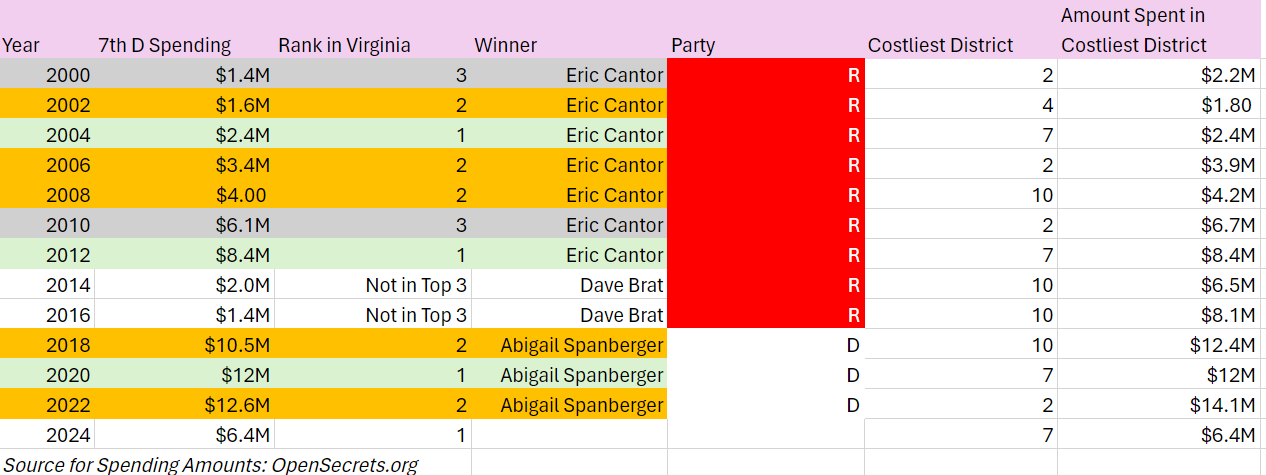
The congressional seat for Virginia District 7 has always been among the most expensive in the commonwealth, but the cost has exploded in recent years. In 2024, the cost is likely going to rise again.
Virginia is the exception to much of the South in one very good way – its congressional districts are not unfairly gerrymandered. That’s the judgment, at least, of the Gerrymandering Project out of Princeton University.
Virginia shows no partisan advantage and receives a grade of A for its congressional districting. Compare that to North Carolina, South Carolina, Tennessee, Georgia, and Florida – each of which leans strong Republican and the congressional districting in each state receives a score of F.
Gerrymandering may not currently be an issue in the commonwealth, but that hasn’t stopped the cash from flowing into the 7th District congressional races. That Virginia’s districts are fairly drawn may, in fact, increase the flow of money.
Congressional elections have been nationalized since 1994, when Newt Gingrich developed the strategy. Today, with margins in Congress separated often by just a few seats, the competition to win a few competitive districts in states like Virginia attracts national attention, and national dollars.
Here in Virginia, that reality has been accelerating over the past few election cycles.
Since at least 2000, District 7 – currently held by Abigail Spanberger, who’s retiring this year to run for governor in 2025 – has been home to one of the most-expensive congressional races in Virginia.

Between 2000 and 2022, the 7th District has rated as either the first- (2004, 2012, 2020), second- (2002, 2006, 2008, 2018, 2022) or third-most-expensive (2000, 2010) congressional race in the commonwealth.
The only years it wasn’t among the Top 3 in Virginia were 2014 and 2016 – both races won by Dave Brat (R).
Moreover, the amount to win this seat has accelerated significantly since 2016. Between 2000 and 2016, the total spent on 7th District races was $30.7 million. But Between 2018 and 2022 – a period one-fourth as long – total spending in 7th District races has totaled $35.1 million according to data collected from OpenSources.org.
Based on current spending levels, the race this year could break the record for money spent in 2022 – $12.6 million.
What’s Going On?
Though the 7th District is generally considered a solid purple district – Spanberger won with just 50.3% of the vote in 2018, and 50.8% in 2020 – it tilted more in favor of the Democrats in the last redistricting, with the center of power shifting from Richmond to Prince William. That helps explain why Spanberger won by her largest margin with 52.2% of the vote in 2022.
But Spanberger’s win is also a tribute to get-out-the-vote efforts and fundraising.
Her rise to power has created a playbook for Democrats to follow in close races. In 2014 and 2016, Democrats had no serious chance to win the seat; this lack of confidence was reflected in how badly they were outspent by Dave Brat and Republicans.
In 2014, Brat outspent Democrat Jack Trammell by almost 3-to-1. And in 2016, Brat outspent Democrat Eileen Bedell by almost 4-to-1.
Spanberger, however, put together a convincing argument that Democrats could win in 2018, and that opened the proverbial spigots.
“When the Seventh was largely a suburban Richmond district (before the 2020 Census redistricting),” says Mary Washington University professor Stephen Farnsworth, “it was seen as safely Republican, at least until Abigail Spanberger demonstrated a Democratic candidate could win there.”
Once the race became competitive in 2018, however, there was no shortage of cash to be had.
“The Seventh District,” says Farnsworth, “has become one of the most expensive districts in the nation for two reasons: it is the most competitive congressional district in the very expensive Washington television market, and the district’s proximity to DC means that candidates have no problem raising a lot of money from the wealthy donors. Both parties want the bragging rights that come from winning this high-profile district.”
Republicans over the past three congressional elections haven’t failed to raise funds in the 7th District, they simply haven’t been able to keep pace with Democrats.
In 2018, Spanberger outspent incumbent Dave Brat by more than 2-to-1 in a very tight race. She performed similarly in 2020, outspending Nick Feitas (R) by more than 2-to-1, as well.
And in 2022, Yesli Vega’s spend of some $3.5 million was eclipsed by Spanberger’s $9.2 million.
Greenbacks Are Flowing
Eugene Vindman, like Spanberger, is a fundraising juggernaut.
In fact, he’s currently trouncing his closest Republican competitor – Derrick Anderson – by more than 4-to-1. ($3.7 million raised for Vindman; $885,000 for Anderson.)
Vindman’s Democratic candidates are also struggling to stay apace of the party’s leading fundraiser. None of Vindman’s other competitors are even close to having raised $1 million.
The giving on the Republican side is likely to accelerate quickly as we move toward the primary on June 18. Though Anderson is currently out front, Cameron Hamilton is getting support from Rand Paul (R-Kentucy) in his bid. Recently, Paul stumped for Hamilton in an ad that was paid for by the Protect Freedom PAC.
Where’s all the money coming from? Increasingly, from outside Virginia. From 2000-2008, in-state contributions were consistently higher than out-of-state contributions. In 2010 and 2012, Eric Cantor managed to bring in more out-of-state dollars than in-state, probably due in part to the national profile he had created for himself as House Minority Whip from January 3, 2009 – January 3, 2011, and House Majority Leader from January 3, 2011 – August 1, 2014.
Brat never attracted more out-of-state than in-state campaign contributions, according to OpenSecrets.org, in 2014 or 2016, when he won, or 2018 when he lost.
However, Spanberger attracted more out-of-state than in-state support in all three of her runs for Congress. (See totals from 2018, 2020, and 2022 per OpenSecrets.) Her Republican contenders, by contrast, never did receive more out-of-state funds than in-state.
By contrast, early in the 2024 campaign Vindman, Anderson, and Hamilton all have more out-of-state dollars than in-state.
Whoever comes out on top in June, and again in November, will likely do so on the back of a record-breaking campaign haul. Vindman’s national profile, and Republican’s targeting this district as a possible pick-up, will attract a lot of national attention – and a lot of out-of-state dollars.
Game on.





